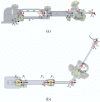Development of a Real-Time 6-DOF Motion-Tracking System for Robotic Computer-Assisted Implant Surgery
- PMID: 36904653
- PMCID: PMC10007561
- DOI: 10.3390/s23052450
Development of a Real-Time 6-DOF Motion-Tracking System for Robotic Computer-Assisted Implant Surgery
Abstract
In this paper, we investigate a motion-tracking system for robotic computer-assisted implant surgery. Failure of the accurate implant positioning may result in significant problems, thus an accurate real-time motion-tracking system is crucial for avoiding these issues in computer-assisted implant surgery. Essential features of the motion-tracking system are analyzed and classified into four categories: workspace, sampling rate, accuracy, and back-drivability. Based on this analysis, requirements for each category have been derived to ensure that the motion-tracking system meets the desired performance criteria. A novel 6-DOF motion-tracking system is proposed which demonstrates high accuracy and back-drivability, making it suitable for use in computer-assisted implant surgery. The results of the experiments confirm the effectiveness of the proposed system in achieving the essential features required for a motion-tracking system in robotic computer-assisted implant surgery.
Keywords: Agile Eye; back-drivability; dental surgery; motion-tracking system; robotic computer-assisted implant surgery.
Conflict of interest statement
The authors declare no conflict of interest.
Figures
















References
-
- Kühl S., Zürcher S., Mahid T., Müller-Gerbl M., Filippi A., Cattin P. Accuracy of full guided vs. half-guided implant surgery. Clin. Oral Implant. Res. 2013;24:763–769. - PubMed
-
- Santis D.D., Malchiodi L., Cucchi A., Cybulski A., Verlato G., Gelpi F., Nocini P.F. The Accuracy of Computer-Assisted Implant Surgery Performed Using Fully Guided Templates versus Pilot-Drill Guided Templates. Biomed. Res. Int. 2019;2019:9023548. doi: 10.1155/2019/9023548. - DOI
-
- Park J.M., Kim J., Shim J.S. Review of Computer-assisted Implant Surgeries: Navigation Surgery System vs. Computer-guided Implant Template vs. Robot. Korean Acad. Oral Maxillofac. Implantol. 2018;22:50–58. doi: 10.32542/implantology.20180005. - DOI
MeSH terms
Grants and funding
LinkOut - more resources
Full Text Sources
Other Literature Sources

